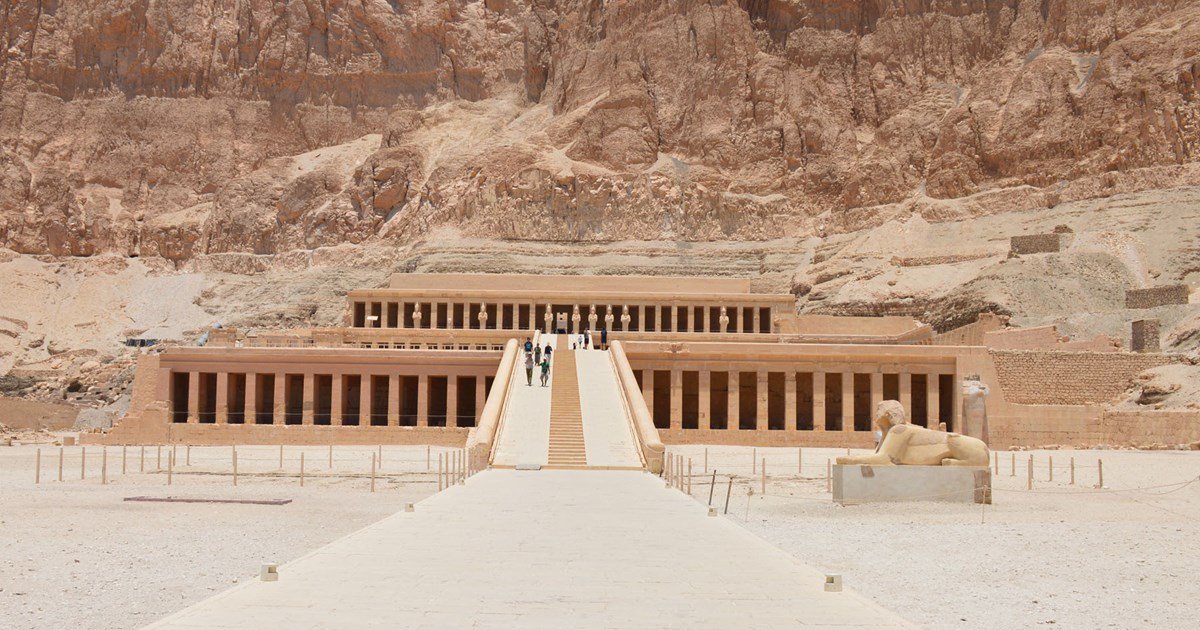
On the west bank of Luxor, in the cliffs of Deir el-Bahari, stands one of ancient Egypt’s most remarkable monuments—the Mortuary Temple of Queen Hatshepsut. This temple is not just a structure; it’s a bold statement of ambition, elegance, and timeless power carved into the mountain itself.
Who Was Queen Hatshepsut?
Hatshepsut was one of the few women to rule Egypt as Pharaoh. Daughter of Thutmose I and wife of Thutmose II, she rose to power during the 18th Dynasty and ruled with wisdom and strength. To legitimize her reign, she adopted royal symbols—including the ceremonial beard—and commissioned grand projects to immortalize her legacy.
Her temple was built to honor her achievements and her divine connection to Amun-Ra, the chief god of Thebes.
Architectural Brilliance: Nature and Design in Harmony
Designed by her trusted architect Senenmut, the temple is a masterpiece of ancient Egyptian architecture.
It features:
- Three massive terraces, rising in perfect symmetry
- Wide ramps connecting each level
- Colonnades with elegant pillars and carved reliefs
- Sanctuaries and chapels dedicated to gods like Hathor and Anubis
The temple is carved directly into the cliff face, blending seamlessly with the natural rock and creating a breathtaking visual harmony.
The Expedition to Punt: Trade and Diplomacy
One of the most famous scenes depicted on the temple walls is Hatshepsut’s expedition to the Land of Punt—a legendary trading journey.
This mission brought back:
- Gold and incense
- Exotic animals and rare plants
- Diplomatic ties with distant lands
The carvings show detailed ships, foreign landscapes, and respectful exchanges, highlighting Hatshepsut’s success in international relations.
Visiting the Temple Today
Exploring Hatshepsut Temple is like stepping into a living museum.
- At sunrise, the cliffs glow golden and the temple radiates quiet majesty
- Visitors can walk through ancient halls, read hieroglyphs, and feel the spirit of a queen who defied tradition
- The temple overlooks the Valley of the Kings, adding depth to its spiritual and historical significance
Cultural and Historical Significance
Hatshepsut’s Temple stands as a symbol of:
- Female leadership in a male-dominated era
- Architectural innovation that influenced future temple designs
- Religious devotion and political messaging
- Egypt’s golden age of peace, prosperity, and artistic achievement
Frequently Asked Questions (FAQs)
Q1: Why is Hatshepsut Temple unique?
Because it was built by a female Pharaoh and carved into a cliff, blending nature and architecture.
Q2: Can visitors enter the temple?
Yes, the site is open to tourists and includes access to terraces, chapels, and reliefs.
Q3: What’s the best time to visit?
From October to April, when the weather is cooler and ideal for exploring Luxor’s West Bank.
Q4: How do I get there?
The temple is located near the Valley of the Kings, about 30 minutes from central Luxor by car or guided tour.
Q5: Is it safe and accessible?
Yes, it’s a secure and well-maintained site, regularly visited by international travelers.
Conclusion
The Temple of Hatshepsut is more than a monument—it’s a message carved in stone. It tells the story of a woman who ruled with vision, built with brilliance, and left behind a legacy that still inspires. Whether you’re drawn by history, architecture, or the spirit of ancient Egypt, this temple offers an unforgettable journey into the heart of greatness.
Would you like me to add hashtags and keywords for this post? I can prepare them instantly.
